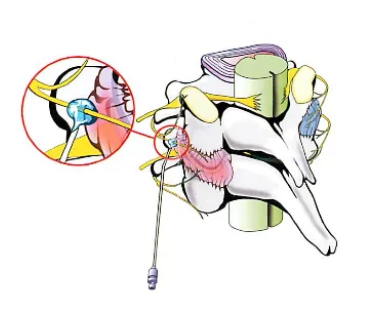Cervical Medial Branch Block
Cervical Medial Branch Block
For Chronic Neck Pain & Headache
A cervical medial branch block is an outpatient procedure for diagnosing and treating neck, shoulder upper back and headache pain.
What are cervical facet joints?
Facet joints connect the vertebrae, the bones of the spine. They help guide your spine when you move. The neck area of the spine is called the cervical region. It contains seven vertebrae. Facet joints are found on both sides of the spine. Each is about the size of a thumbnail. Cervical facet joints are named for the vertebrae they connect and the side of the spine where they are found. The right C2-3 facet joint, for example, joins the 2nd and 3rd vertebrae on the right side. Medial branch nerves are found near facet joints. They transmit pain signals from the facet joints to your brain.

What is cervical facet joint pain?
You may feel pain if a cervical facet joint is injured. Sometimes it feels like muscle tension. Other times it can be a severe pain. The cartilage inside the joint may be injured. Other times only connecting ligaments surrounding the joint are injured. Facet pain also depends on which facet joints are affected. Pain from cervical facet joints occurs in an area from your head down to your lower shoulder blade. The diagram shows areas of pain usually associated with specific joints.
How do I know if I have cervical facet pain?
If you have pain in one or more of these areas, and it lasts longer than two months, you may have cervical facet pain. Common tests such as x-rays or MRIs, may not always show if a facet joint is causing pain.
What is a cervical medial branch block?
In a cervical medial branch block, a local anesthetic (numbing medicine) is injected near the medial branch nerve. This stops the transmission of pain signals from the facet joint. If this reduces your pain and helps you move your neck like normal, it may tell the doctor which facet joint is causing the pain.

What happens during an injection?
A local anesthetic will be used to numb your skin. The doctor will then insert a small needle near the medial branch nerve. Fluoroscopy, a type of x-ray, must be used to ensure the safe and proper position of the needle. Dye will also be injected to make sure the needle is at the correct spot. Once the doctor is sure the needle is correctly placed, the anesthetic will be injected.
What happens after an injection?
You will be monitored for up to 30 minutes after the injection. When you are ready to leave, the staff will give you discharge instructions. You will also be given a pain diary. It is important to fill this out because it helps your doctor know how the injection is working. It will help to move your neck in ways that hurt before the injection, to see if the pain is still there, but do not overdo it. Take it easy for the rest of the day. You may feel immediate pain relief and numbness in your neck for a limited period of time after the injection. This may indicate the medication has reached the right spot. You can usually return to work the day after the injection, but always check with your doctor.
How long can I expect pain relief?
The extent and duration of pain relief may depend on the amount of inflammation and how many areas are involved. Other coexisting factors may be responsible for your pain. If your pain goes away for a short time, but then returns, you may be a candidate for radiofrequency ablation (RFA) of the medial branch nerve. This procedure provides a more sustained disruption of pain signals, and often prolonged pain relief.
